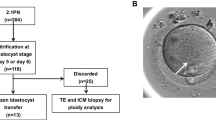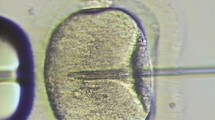Abstract
Purpose
To detect expression of bone morphogenetic protein 15 (BMP15) and growth differentiation factor 9 (GDF9) in oocytes, and their receptor type 2 receptor for BMPs (BMPR2) in cumulus cells in women with polycystic ovary syndrome (PCOS) undergoing in vitro fertilization (IVF), and determine if BMPR2, BMP15, and GDF9 expression correlate with hyperandrogenism in FF of PCOS patients.
Methods
Prospective case–control study. Eighteen MII-oocytes and their respective cumulus cells were obtained from 18 patients with PCOS, and 48 MII-oocytes and cumulus cells (CCs) from 35 controls, both subjected to controlled ovarian hyperstimulation (COH), and follicular fluid (FF) was collected from small (10–14 mm) and large (>18 mm) follicles. RNeasy Micro Kit (Qiagen®) was used for RNA extraction and gene expression was quantified in each oocyte individually and in microdissected cumulus cells from cumulus-oocyte complexes retrieved from preovulatory follicles using qRT-PCR. Chemiluminescence and RIA assays were used for hormone assays.
Results
BMP15 and GDF9 expression per oocyte was higher among women with PCOS than the control group. A positive correlation was found between BMPR2 transcripts and hyperandrogenism in FF of PCOS patients. Progesterone values in FF were lower in the PCOS group.
Conclusion
We inferred that BMP15 and GDF9 transcript levels increase in mature PCOS oocytes after COH, and might inhibit the progesterone secretion by follicular cells in PCOS follicles, preventing premature luteinization in cumulus cells. BMPR2 expression in PCOS cumulus cells might be regulated by androgens.

Similar content being viewed by others
References
March WA, Moore VM, Willson KJ, Phillips DI, Norman RJ, Davies MJ. The prevalence of polycystic ovary syndrome in a community sample assessed under contrasting diagnostic criteria. Hum Reprod. 2010;25:544–51.
Toulis KA, Gouli DG, Farmakiotis D, Georgopoulos NA, Katsikis I, Tarlatzis BC, et al. Adiponectin levels in women with polycystic ovary syndrome: a systematic review and a meta-analysis. Hum Reprod Update. 2009;15:297–307.
Wood JR, Ho CKM, Nelson-Degrave VL, MacAllister JM, Strauss JF. The molecular signature of polycystic ovary syndrome (PCOS) theca cells defined by gene expression profiling. J Reprod Immunol. 2004;63(1):51–60.
Diao FY, Xu M, Hu Y, Li J, Xu Z, Lin M, et al. The molecular characteristics of polycystic ovary syndrome (PCOS) ovary defined by human ovary cDNA microarray. J Mol Endocrinol. 2004;33:59–72.
Wood JR, Dumesic DA, Abbott DH, Strauss JF. Molecular abnormalities in oocytes from women with polycystic ovary syndrome revealed by microarray analysis. J Clin Endocrinol Metabol. 2007;92(2):705–13.
Wood JR, Nelson VL, Ho C, Jansen E, Wang CY, Urbanek M, et al. The molecular phenotype of polycystic ovary syndrome (PCOS) theca cells and new candidate PCOS genes defined by microarray analysis. J Biol Chem. 2003;278:26380–90.
Teixeira Filho FL, Baracat EC, Lee TH, Suh CS, Matsui M, Chang RJ, et al. Aberrant expression of growth differentiation factor-9 in oocytes of women with polycystic ovary syndrome. J Clin Endocrinol Metabol. 2002;87:1337–44.
Dong J, Albertini DF, Nishimori K, Kumar TR, Lu N, Matzuk MM. Growth differentiation factor-9 is required during early ovarian folliculogenesis. Nature. 1996;383:531–5.
Fabre S, Pierre A, Mulsant P, Bodin L, Di Pasquale E, Persani L, et al. Regulation of ovulation rate in mammals: contribution of sheep genetic models. Reprod Biol Endocrinol. 2006;4:20.
Liu J, Wang B, Wei Z, Zhou P, Zu Y, Zhou S, et al. Mutational analysis of human bone morphogenetic protein 15 in Chinese women with polycystic ovary syndrome. Metabol Clin Experiment. 2011;60:1511–4.
Gonzalez A, Ramırez-Lorca R, Calatayud C, Mendoza N, Ruiz A, Saéz ME, et al. Association of genetic markers within the BMP15 gene with anovulation and infertility in women with polycystic ovary syndrome. Fertil Steril. 2008;90:447–9.
Kovanci E, Rohozinski J, Simpson JL, Heard MJ, Bishop CE, Carson SA. Growth differentiation factor-9 mutations may be associated with premature ovarian failure. Fertil Steril. 2007;87:143–6.
Takebayashi K, Takakura K, Wang HQ, Kimura F, Kasahara K, Noda Y. Mutation analysis of the growth differentiation factor-9 and -9B genes in patients with premature ovarian failure and polycystic ovary syndrome. Fertil Steril. 2000;74(5):976–9.
Abir R, Fisch B. Invited commentary: a single nucleotide polymorphism in BMP15 is associated with high response to controlled ovarian hyperstimulation. Reprod BioMed Online. 2011;23:77–80.
Kedem A, Fisch B, Garor R, Ben-Zaken A, Gizunterman T, Felz C, et al. Growth differentiating factor 9 (GDF9) and bone morphogenetic protein 15 both activate development of human primordial follicles in vitro, with seemingly more beneficial effects of GDF9. J Clin Endocrinol Metab. 2011;96(8):E1246–54.
Oron G, Fisch B, Ao A, Zhang XY, Farhi J, Ben Haroush A, et al. Expression of growth differentiating factor 9 and its type 1 receptor in human ovaries. Reprod BioMed Online. 2010;21:109–17.
Sun RZ, Lei L, Cheng L, Jin ZF, Zu SJ, Shan ZY, et al. Expression of GDF-9, BMP-15 and their receptors in mammalian ovary follicles. J Mol Histol. 2010;41:325–32.
Assou S, Haouzi D, De Vos J, Hamamah S. Human cumulus cells as biomarkers for embryo and pregnancy outcomes. Mol Hum Reprod. 2010;16(8):531–8.
Chand AL, Ponnampalam AP, Harris SE, Winship IM, Shelling AN. Mutational analysis of BMP15 and GDF9 as candidate genes for premature ovarian failure. Fertil Steril. 2006;86:1009–12.
Wei LN, Liang XY, Fang C, Zhang MF. Abnormal expression of growth differentiation factor 9 and bone morphogenetic protein 15 in stimulated oocytes during maturation from women with polycystic ovary syndrome. Fertil Steril. 2011;96(2):464–8.
Zhao SY, Qiao J, Chen YJ, Liu P, Li J, Yan J. Expression of growth differentiation factor-9 and bone morphogenetic protein-15 in oocytes and cumulus granulosa cells of patients with polycystic ovary syndrome. Fertil Steril. 2010;94:261–7.
Jayawardana BC, Shimizu T, Nishimoto H, Ei Kaneko, Tetsuka M, Miyamoto A. Hormonal regulation of expression of growth differentiation factor-9 receptor type I and II genes in the bovine ovarian follicle. Reproduction. 2006;131:545–53.
Miyoshi T, Otsuka F, Suzuki J, Takeda M, Inagaki K, Kano Y, et al. Mutual regulation of follicle stimulating hormone signaling and bone morphogenetic protein system in human granulosa cells. Biol Reprod. 2006;74:1073–82. PubMed: 16436528.
Shimizu T, Jayawardana BC, Nishimoto H, Kaneko E, Tetsuka M, Miyamoto A. Involvement of the bone morphogenetic protein/receptor system during follicle development in the bovine ovary: Hormonal regulation of the expression of bone morphogenetic protein 7 (BMP-7) and its receptors (ActRII and ALK-2). Mol Cell Endocrinol. 2006;249(1–2):78–83.
Mazebourg S, Klein C, Roh J, Kaivo-Oja N, Mottershead DG, Korchynskyi O, et al. Growth differentiation factor-9 signaling is mediated by the type I receptor, activin receptor like kinase 5. Mol Endocrinol. 2004;18:653–65. Pubmed: 14684852.
Abir R, Ben-Haroush A, Melamed N, Felz C, Nitke S, Krissi H, et al. The expression of bone morphogenetic proteins 4 and 7 and their receptors IA, IB and II in human ovaries from fetuses and adults. Fertil Steril. 2008;89:1430–3. Pubmed: 17624341.
Shimasaki S, Moore RK, Otsuka F, Erickson GF. The bone morphogenetic protein system in mammalian reproduction. Endocr Rev. 2004;25(1):72–101.
Edwards SJ, Reader KL, Lun S, Western A, Lawrence S, McNatty KP, et al. The cooperative effect of growth and differentiation factor-9 and bone morphogenetic protein (BMP)-15 on granulosa cell function is modulated primarily through BMP receptor II. Endocrinol. 2008;149(3):1026–30.
Moore RK, Otsuka F, Shimasaki S. Molecular basis of bone morphogenetic protein-15 signaling in granulosa cells. J Biol Chem. 2003;278(1):304–10.
WHO laboratory manual for the examination and processing of human semen - 5th ed. http://www.who.int/reproductivehealth/publications/infertility/9789241547789/en/index.html.
Rotterdam ESHRE/ASRM-Sponsored PCOS Consensus Workshop Group Revised 2003 consensus on diagnostic criteria and long-term health risks related to polycystic ovary syndrome. Fertil Steril. 2004; 81:19-25 (PubMed: 14711538).
Livak KJ, Schmittgen TD. Analysis of relative gene expression data using real-time quantitative PCR and the 2(-Delta Delta C(T)) Method. Methods. 2001;25(4):402–8.
Duffy DM. Growth Differentiation Factor-9 Is Expressed by the Primate Follicle Throughout the Periovulatory Interval. Biol Reprod. 2003;69:725–32.
Franks S. Adult polycystic ovary syndrome begins in childhood. Best Pract Res Clin Endocrinol Metab. 2002;16(2):263–72.
Guéripel X, Brun V, Gougeon A. Oocyte bone morphogenetic protein 15, but not growth differentiation factor 9, is increased during gonadotropin-induced follicular development in the immature mouse and is associated with cumulus oophorus expansion. Biol Reprod. 2006;75:836–43.
Wachs DS, Coffler MS, Malcom PJ, Chang RJ. Comparison of follicle-stimulating-hormone-stimulated dimeric inhibin and estradiol responses as indicators of granulosa cell function in polycystic ovary syndrome and normal women. J Clin Endocrinol Metab. 2006;91:2920–5.
Moron FJ, Castro F, Royo JL, Montoro L, Mira E, Saéz ME, et al. A Bone morphogenetic protein 15 (BMP15) alleles predict over-response to recombinant follicle stimulation hormone and iatrogenic ovarian hyperstimulation syndrome (OHSS). Pharmacogenet Genomics. 2006;16:485–495.
Assou S, Anahory T, Pantesco V, Le Carrour T, Pellestor F, Klein B, et al. The human cumulus–oocyte complex gene expression profile. Hum Reprod. 2006;21:1705–19.
Weil S, Vendola K, Zhou J, et al. Androgen and follicle-stimulating hormone interactions in primate ovarian follicle development. J Clin Endocrinol Metab. 1999;84:2951–6.
Naessen T, Kushnir MM, Chaika A, Nosenko J, Mogilevkina I, Rockwood AL, et al. Steroid profiles in ovarian follicular fluid in women with and without polycystic ovary syndrome, analyzed by liquid chromatography-tandem mass spectrometry. Fertil Steril. 2010;94(6):2228–33.
Foong SC, Abbott DH, Zschunke MA, Lesnick TG, Phy JL, Dumesic DA. Follicle luteinization in hyperandrogenic follicles of polycystic ovary syndrome (PCOS) patients undergoing gonadotropin therapy for in vitro fertilization (IVF). J Clin Endocrinol Metab. 2006;91:2327–33.
Wickenheisser JK, Strauss JF, McAllister JM. Reproductive endocrinology Steroidogenic abnormalities in ovarian theca cells in polycystic ovary syndrome. Curr Opin Endocrinol Diabetes. 2002;9:486–91.
Erickson GF, Shimasaki S. The role of the oocyte in folliculogenesis. Trends Endocrinol Metab. 2000;11:193–8.
Yamamoto N, Christenson LK, McAllister JM, Strauss JF. Growth differentiation factor-9 inhibits 3′5′-adenosine monophosphate-stimulated steroidogenesis in human granulosa and theca cells. J Clin Endocrinol Metabol. 2002;87:2849–56.
Otsuka F, Yao Z, Lee T, Yamamoto S, Ericson GF, Shimasaki S. Bone morphogenetic protein-15. Identification of target cells and biological functions. J Biol Chem. 2000;275(50):39523–8.
Welt CK, Jimenez Y, Sluss PM, Smith PC, Hall JE. Control of estradiol secretion in reproductive ageing. Hum Reprod. 2006;21(8):2189–93.
Franks S, Roberts LR, Hardy K. Gonadotrophin regimens and oocyte quality in women with polycystic ovary syndrome. Reprod Biomed Online. 2003;6:181–4.
Vitt UA, Hayashi M, Klein C, Hsueh AJ. Growth differentiation factor-9 stimulates proliferation but suppresses the follicle-stimulation hormone-induced differentiation of cultured granulosa cells from small antral and preovulatory rat follicles. Biol Reprod. 2000;62(2):370–7.
Gilchrist RB, Lane M, Thompson JG. Oocyte-secreted factors: regulators of cumulus cell function and oocytes quality. Hum Reprod Update. 2008;14:159–77.
Moore RK, Shimasaki S. Molecular biology and physiological role of the oocytes factor, BMP-15. Mol Cell Endocrinol. 2005;234:67–73.
Hardy K, Robinson FM, Paraschos T, Wicks R, Franks S, Winston RM. Normal development and metabolic activity of preimplantation embryos in vitro from patients with polycystic ovaries. Hum Reprod. 1995;10:2125–35.
Acknowledgments
We wish to thank the Laboratory of Gynecology and Obstetrics, the Laboratory of Neuroendocrinology in the Department of Internal Medicine, and the Laboratory of Molecular Biology in the Department of Pediatrics at the Clinical Hospital of the Medical College of Ribeirão Preto – São Paulo University, for laboratory procedures. We would also like to thank Claudia Paz for statistical analysis support and Maria Cristina Picinato and Rosane Gomes de Paula Queiroz for technical assistance.
Author information
Authors and Affiliations
Corresponding author
Additional information
Supported by CNPq – 478912/2007.
Capsule
Women with PCOS undergoing COH have increased expression of BMP15 and GDF9 genes in mature oocytes. BMPR2 expression in PCOS cumulus cells might be regulated by androgens.
Rights and permissions
About this article
Cite this article
de Resende, L.O.T., Vireque, A.A., Santana, L.F. et al. Single-cell expression analysis of BMP15 and GDF9 in mature oocytes and BMPR2 in cumulus cells of women with polycystic ovary syndrome undergoing controlled ovarian hyperstimulation. J Assist Reprod Genet 29, 1057–1065 (2012). https://doi.org/10.1007/s10815-012-9825-8
Received:
Accepted:
Published:
Issue Date:
DOI: https://doi.org/10.1007/s10815-012-9825-8




